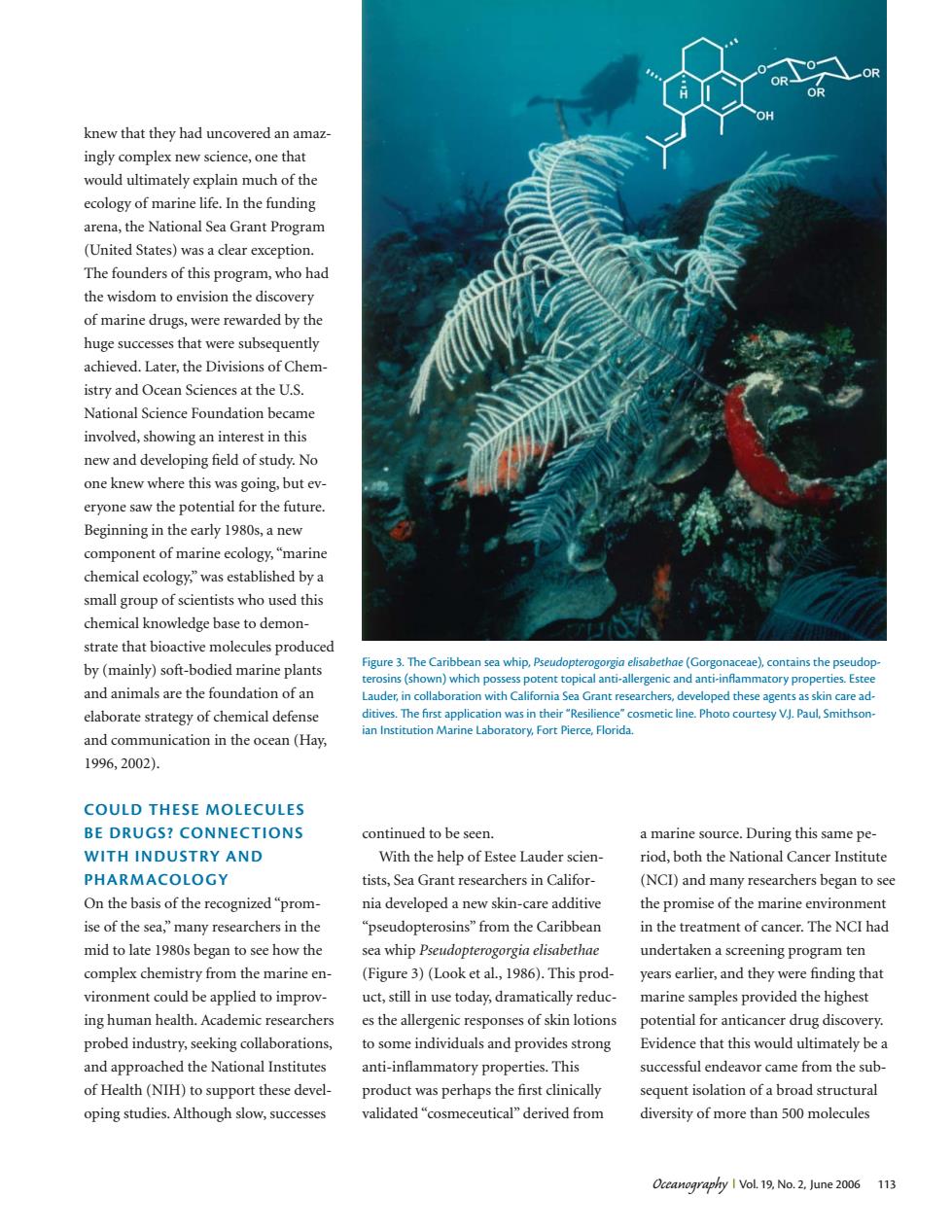正在加载图片...

knew that they had uncovered an amaz- ingly complex new science,one that would ultimately explain much of the ecology of marine life.In the funding arena,the National Sea Grant Program (United States)was a clear exception. The founders of this program,who had the wisdom to envision the discovery of marine drugs,were rewarded by the huge successes that were subsequently achieved.Later,the Divisions of Chem- istry and Ocean Sciences at the U.S National Science Foundation became involyed,showing an interest in this new and developing field of study.No one knew where this was going,but ev- eryone saw the potential for the future. Beginning in the early 1980s,a new component of marine ecology."marine chemical ecology,"was established by small group of scientists who used this chemical knowledge base to demon- strate that bioactive molecules produced e 3.The C sea whip.Pseudo by(mainly)soft-bodied marine plants ins (shov wn)which po and animals are the foundation of ar Lauder,in collaboration with California Sea Grant researchers,developed these agents as skin care ad- elaborate strategy of chemical defense and communication in the ocean(Hay 1996,2002). COULD THESE MOLECULES BE DRUGS?CONNECTIONS continued to be seen. a marine source.During this same pe- WITH INDUSTRY AND With the help of Estee Lauder scien riod,both the National Cancer Institute PHARMACOLOGY tists,Sea Grant researchers in Califor (NCI)and many researchers began to see On the basis of the recognized "prom- nia developed a new skin-care additive the promise of the marine environment ise of the sea,"many researchers in the “pseudopterosins”from the Caribbean in the treatment of cancer.The NCI had mid to late 1980s began to see how the sea whip Pseudopterogorgia elisabethae undertaken a screening program ten complex chemistry from the marine en- (Figure 3)(Look et al,986).This prod- vears earlier,and they were finding that vironment could be applied to improv- uct,still in use today,dramatically reduc marine samples provided the highest ing human health.Academic researchers es the allergenic responses of skin lotions botential for anticancer drug discovery probed industry,seeking collaborations to some individuals and provides strong Evidence that this would utimately bea and approached the national Institutes anti-inflammatory properties.This successful endeavor came from the sub of Health (NIH)to support these devel product was perhaps the first cinically equent isolation of a broad structural oping studies.Although slow,successes validated"cosmeceutical"derived from diversity of more than 500 molecules Occanography I Vol 19.No.2.June 2006 113Oceanography Vol. 19, No. 2, June 2006 113 knew that they had uncovered an amazingly complex new science, one that would ultimately explain much of the ecology of marine life. In the funding arena, the National Sea Grant Program (United States) was a clear exception. The founders of this program, who had the wisdom to envision the discovery of marine drugs, were rewarded by the huge successes that were subsequently achieved. Later, the Divisions of Chemistry and Ocean Sciences at the U.S. National Science Foundation became involved, showing an interest in this new and developing fi eld of study. No one knew where this was going, but everyone saw the potential for the future. Beginning in the early 1980s, a new component of marine ecology, “marine chemical ecology,” was established by a small group of scientists who used this chemical knowledge base to demonstrate that bioactive molecules produced by (mainly) soft-bodied marine plants and animals are the foundation of an elaborate strategy of chemical defense and communication in the ocean (Hay, 1996, 2002). COULD THESE MOLECULES BE DRUGS? CONNECTIONS WITH INDUSTRY AND PHARMACOLOGY On the basis of the recognized “promise of the sea,” many researchers in the mid to late 1980s began to see how the complex chemistry from the marine environment could be applied to improving human health. Academic researchers probed industry, seeking collaborations, and approached the National Institutes of Health (NIH) to support these developing studies. Although slow, successes continued to be seen. With the help of Estee Lauder scientists, Sea Grant researchers in California developed a new skin-care additive “pseudopterosins” from the Caribbean sea whip Pseudopterogorgia elisabethae (Figure 3) (Look et al., 1986). This product, still in use today, dramatically reduces the allergenic responses of skin lotions to some individuals and provides strong anti-infl ammatory properties. This product was perhaps the fi rst clinically validated “cosmeceutical” derived from a marine source. During this same period, both the National Cancer Institute (NCI) and many researchers began to see the promise of the marine environment in the treatment of cancer. The NCI had undertaken a screening program ten years earlier, and they were fi nding that marine samples provided the highest potential for anticancer drug discovery. Evidence that this would ultimately be a successful endeavor came from the subsequent isolation of a broad structural diversity of more than 500 molecules Figure 3. Th e Caribbean sea whip, Pseudopterogorgia elisabethae (Gorgonaceae), contains the pseudopterosins (shown) which possess potent topical anti-allergenic and anti-infl ammatory properties. Estee Lauder, in collaboration with California Sea Grant researchers, developed these agents as skin care additives. Th e fi rst application was in their “Resilience” cosmetic line. Photo courtesy V.J. Paul, Smithsonian Institution Marine Laboratory, Fort Pierce, Florida